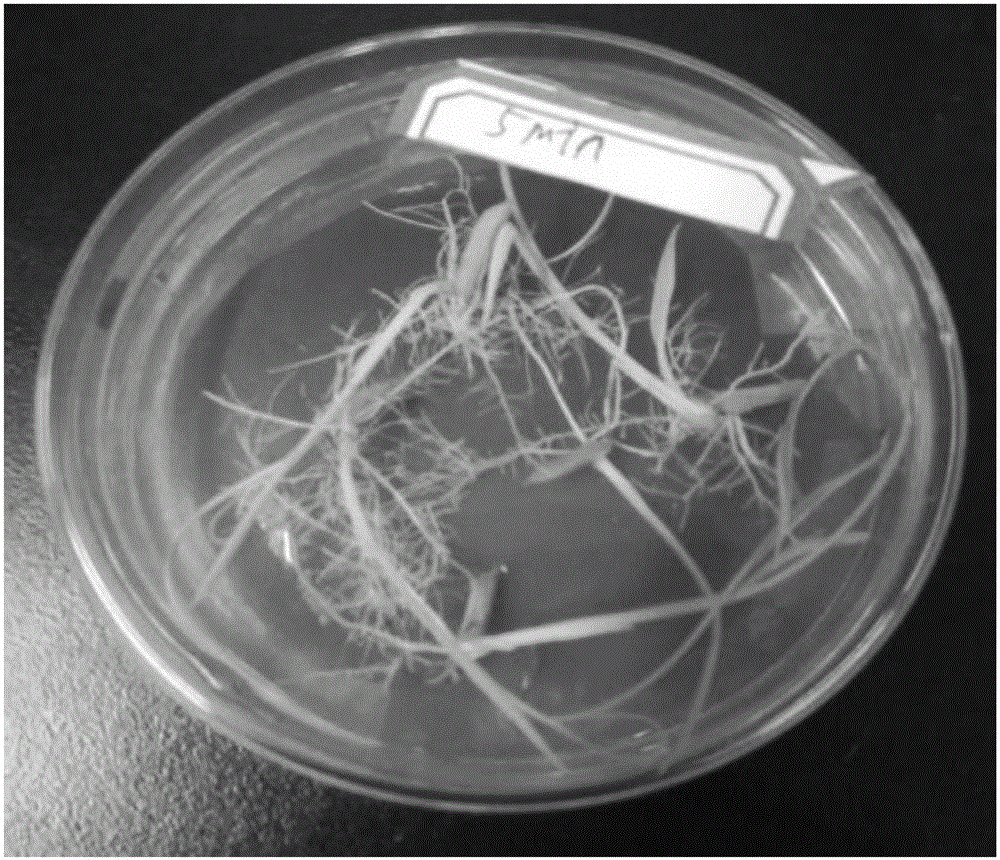Method for culturing sterile paddy seedlings
A cultivation method and technology of aseptic seedlings, applied in the field of plant tissue culture, can solve the problems of increased workload, damage to seed embryos, cumbersomeness, etc., and achieve the effect of easy operation and simple method
- Summary
- Abstract
- Description
- Claims
- Application Information
AI Technical Summary
Problems solved by technology
Method used
Image
Examples
Embodiment 1
[0026] Weigh 5 grams of rice seeds, place it in a beaker, fill the beaker with water, then pull out the rice grains, and let the water soak for 4 hours. At the same time, 5 sets of petri dishes and 3 bottles of 300ml deionized water were sterilized at 121°C for 30 minutes. 40 minutes before the experiment, put the required equipment for the experiment, such as: tweezers, alcohol lamp, sterile potato medium plate, etc. Transfer the soaked rice seeds to a sterilized petri dish in a clean workbench, then add alcohol with a concentration of 75% to the petri dish to cover the rice seeds, pour off the alcohol after soaking for 1 minute, and pour it into the container. Add an appropriate amount of formaldehyde with a concentration of 40% to the petri dish with seeds to make it cover the seeds, pour off the formaldehyde after soaking for 5 minutes, and then wash it three times with sterile water. Then clamp 15 seeds with aseptic tweezers and place them in three sterile potato medium ...
Embodiment 2
[0028] Take by weighing 10 grams of rice seeds, place it in a beaker, fill the beaker with water, then pull out the empty husks of the rice, and let the water soak for 4 hours. At the same time, sterilize one 500ml beaker and five bottles of 300ml deionized water at 121°C for 30min. 40 minutes before the experiment, put the required equipment for the experiment, such as: tweezers, alcohol lamp, sterile polyethylene high-temperature-resistant culture cup with wet gauze inside, etc. After the sterilization is completed, transfer the soaked rice seeds to a sterilized beaker in the ultra-clean workbench, then add alcohol with a concentration of 70% to the beaker to cover the rice seeds, soak for 2 minutes and then pour it out Alcohol, and then add an appropriate amount of formaldehyde with a concentration of 40% to the beaker containing the seeds to make it submerge the seeds, pour off the formaldehyde after soaking for 5 minutes, and then wash it three times with sterile water. ...
Embodiment 3
[0030] Take by weighing 10 grams of rice seeds, place it in a beaker, fill the beaker with water, then fish out the empty husks of the rice, and let the water soak for 8 hours. At the same time, sterilize one 500ml beaker and five bottles of 300ml deionized water at 121°C for 30min. 40 minutes before the experiment, put the required equipment for the experiment, such as: tweezers, alcohol lamp, sterile polyethylene high-temperature-resistant culture cup with wet gauze inside, etc. After the sterilization is completed, transfer the soaked rice seeds to a sterilized beaker in the ultra-clean workbench, then add alcohol with a concentration of 75% to the beaker to cover the rice seeds, soak for 1 minute and then pour it out Alcohol, and then add an appropriate amount of formaldehyde with a concentration of 38% to the beaker containing the seeds to make it submerge the seeds, pour off the formaldehyde after soaking for 5 minutes, and then wash it three times with sterile water. T...
PUM
 Login to View More
Login to View More Abstract
Description
Claims
Application Information
 Login to View More
Login to View More - R&D
- Intellectual Property
- Life Sciences
- Materials
- Tech Scout
- Unparalleled Data Quality
- Higher Quality Content
- 60% Fewer Hallucinations
Browse by: Latest US Patents, China's latest patents, Technical Efficacy Thesaurus, Application Domain, Technology Topic, Popular Technical Reports.
© 2025 PatSnap. All rights reserved.Legal|Privacy policy|Modern Slavery Act Transparency Statement|Sitemap|About US| Contact US: help@patsnap.com



